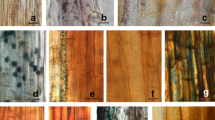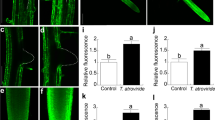Abstract
Phytophthora cinnamomi occurs worldwide and has a host range in excess of 1,000 plant species. Avocados (Persea americana Mill) have been described as highly susceptible to this soil-borne pathogen. Here, the regulation of defence responses in avocado root seedlings inoculated with P. cinnamomi mycelia is described. A burst of reactive oxygen species (ROS) was observed 4 days after inoculation. The higher physiological concentration of H2O2 induced by P. cinnamomi on avocado roots had no effect on in vitro growth of the oomycete. Total phenols and epicathecin content showed a significant decrease, but lignin and pyocianidins exhibited no changes after inoculation. Also, increased nitric oxide (NO) production was observed 72 h after treatment. We studied the effects of one NO donor [sodium nitroprusside (SNP)], and one NO scavenger [2- to 4-carboxyphenyl-4,4,5,5-tetramethylimidazole-1-oxyl-3-oxide (CPTIO)] to determine the role of NO during root colonisation by P. cinnamomi mycelia. Pretreatment of the roots with CPTIO, but not with SNP, inhibited root colonisation suggesting an important role for NO production during the avocado–P. cinnamomi interaction. Our data suggest that although defence responses are activated in avocado roots in response to P. cinnamomi infection, these are not sufficient to avoid pathogen invasion.






Similar content being viewed by others
Abbreviations
- APX:
-
Ascorbate peroxidase
- CAT:
-
Catalase
- CPTIO:
-
2- to 4-carboxyphenyl-4,4,5,5-tetramethylimidazole-1-oxyl-3-oxide
- GPX:
-
Guaiacol peroxidase
- H2O2 :
-
Hydrogen peroxide
- MAMPs:
-
Microbe associated molecular patterns
- NO:
-
Nitric oxide
- O −2 :
-
Superoxide anion
- PAMPs:
-
Pathogen associated molecular patterns
- POD:
-
Peroxidase
- ROS:
-
Reactive oxygen species
- SNP:
-
Sodium nitroprusside
- SOD:
-
Superoxide dismutase
- TBARS:
-
Thiobarbituric acid
- XTT:
-
Sodium 3′ –[1-[phenylamino-carbonyl]-3,4-tetrazolium]-bis(4-methoxy-6nitro) benzene-sulfonic acid hydrate
References
Able AJ (2003) Role of reactive oxygen species in the response of barley to necrotrophic pathogens. Protoplasma 221:137–143
Able AJ, Guest DI, Sutherland MW (1998) Use of a new tetrazolium-based assay to study the production of superoxide radicals by tobacco cell cultures challenged with avirulent zoospores of Phytophthora parasitica var nicotianae. Plant Physiol 117:491–499
Anderson M, Chen Z, Klessig DF (1998) Possible involvement of lipid peroxidation in salicylic acid-mediated induction of PR-1 gene expression. Phytochemistry 47:555–566
Apel K, Hirt H (2004) Reactive oxygen species: metabolism, oxidative stress, and signal transduction. Annu Rev Plant Biol 55:373–399
Barret DM, Gonzalez C (1994) Activity of softening enzymes during cherry maturation. J Food Sci 59:574–577
Bittel P, Robatzek S (2007) Microbe-associated molecular patterns (MAMPs) probe plant immunity. Curr Opin Plant Biol 10:335–341
Boller T, Felix G (2009) A renaissance of elicitors: perception of microbe-associated molecular patterns and danger signals by pattern-recognition receptors. Annu Rev Plant Biol 60:379–406
Bradford M (1976) A rapid and sensitive method for the quantification of microgram quantities of protein utilizing the principle of protein-dye binding. Ann Biochem 72:248–254
Bruce RJ, West CA (1989) Elicitation of lignin biosynthesis and isoperoxidase activity by pectic fragments in suspension cultures of castor bean. Plant Physiol 91:889–897
Cahill DM, Rookes JE, Wilson BA, Gibson L, McDouglas KL (2008) Phytophthora cinnamomi and Austalia´s biodiversity: impats, predictions and progress towards control. Aust J Bot 56:279–310
Cakmak I, Marschner RP (1992) Magnesium deficiency and high light intensity enhance activities of superoxide, ascorbate peroxidase, glutathione reductase in bean leaves. Plant Physiol 98:1222–1227
Chen Z, Klessig DF (1991) Identification of a soluble salicylic acid-binding protein that may function in signal transduction in the plant disease-resistance response. Proc Natl Acad Sci USA 88:8179–8183
Chen Y, Wang D (2005) Two convenient methods to evaluate soybean for resistance to Sclerotinia sclerotiorum. Plant Dis 89:1268–1272
Chen Z, Silva H, Klessig DF (1993) Active oxygen species in the induction of plant systemic acquired resistance by salicylic acid. Science 262:1883–1886
Conrath U, Chen Z, Ricigliano JW, Klessig DF (1995) Two inducers of plant defence responses, 2, 6-dichloroisonicotinic acid and salicylic acid, inhibit catalase activity in tobacco. Proc Natl Acad Sci USA 92:7143–7147
De Gara L, Paciolla C, De Tullio MC, Mottoc M, Arrigoni O (2000) Ascorbate- dependent hydrogen peroxide detoxification and ascorbate regeneration during germination of a highly productive maize hybrid: evidence of an improved detoxification mechanism against reactive oxygen species. Physiol Plant 109:7–13
Delledonne M, Zeier J, Marocco A, Lamb C (2001) Signal interactions between nitric oxide and reactive oxygen intermediates in the plant hypersensitive disease resistance response. Proc Natl Acad Sci USA 98:13454–13459
Dempsey DA, Shah J, Klessig DF (1999) Salicylic acid and disease resistance in plants. Crit Rev Plant Sci 18:547–575
Dickinson M (2003) Fungal and oomycete diseases–development of disease. In: Dickinson M (ed) Molecular plant pathology. Taylor and Francis, New York, pp 47–63
Dong X, Braun EL, Grotewold E (2001) Functional conservation of plant secondary metabolic enzymes revealed by complementation of Arabidopsis flavonoid mutants with maize genes. Plant Physiol 127:46–57
Durner J, Shah J, Klessig DF (1997) Salicylic acid and disease resistance in plants. Trends Plant Sci 2:266–274
Durner J, Wendehenne D, Klessig DF (1998) Defence gene induction in tobacco by nitric oxide, cyclic GMP, and cyclic ADP-ribose. Proc Natl Acad Sci USA 95:10328–10333
Duthie SJ, Johnson W, Dobson VL (1997) The effects of dietary flavonoids on DNA damage (strand breaks and oxidized pyrimidines) and growth in human cells. Mutat Res 390:141–151
Glazebrook J (2005) Contrasting mechanisms of defence against biotrophic and necrotrophic pathogens. Annu Rev Phytopathol 43:205–227
Gess R, Coffey MD (1989) Evaluation of a strain of Myrothecium roridum as a potential biocontrol agent against Phytophthora cinnamomi. Phytopathology 79:1079–1084
Govrin EM, Levine A (2000) The hypersensitive response facilitates plant infection by the necrotrophic pathogen Botrytis cinerea. Curr Biol 10:751–757
Huang X, Stettmaier K, Michel C, Hutzler P, Mueller MJ, Durner J (2004) Nitric oxide is induced by wounding and influences jasmonic acid signaling in Arabidopsis thaliana. Planta 218:938–946
Hutchenson SW (1998) Current concepts of active defence in plants. Annu Rev Phytopathol 36:59–90
Jones JD, Dangl JL (2006) The plant immune system. Nature 444:323–329
Kaluza WZ, McGrath RM, Reberts TC, Schroder HH (1980) Separation of phenolics of sorghum bicolour (L.) Moench grain. J Agric Food Chem 28:1191–1196
Kauss H, Theisinger-Hinkel E, Mindermann R, Conrath U (1992) Dichloroisonicotinic and salicylic acid, inducers of systemic acquired resistance, enhance fungal elicitor responses in parsley cells. Plant J 2:655–660
Kauss H, Jeblick W (1995) Pretreatment of parsley suspension cultures with salicylic acid enhances spontaneous and elicited production of H2O2. Plant Physiol 108:1171–1178
Kawano T, Sahashi N, Takahashi K, Uozumi N, Muto S (1998) Salicylic acid induces extracellular superoxide generation followed by an increase in cytosolic calcium ion in tobacco suspension culture: the earliest events in salicylic acid signal transduction. Plant Cell Physiol 39:721–730
Kessler A, Baldwin IT (2002) Plant response to herbivory: the emerging molecular analysis. Annu Plant Biol 53:299–328
Laloi C, Apel K, Danon A (2004) Reactive oxygen signalling: the latest news. Curr Opin Plant Biol 7:323–328
Latijnhouwers M, de Wit JGM, Govers F (2003) Oomycetes and fungi: similar weaponry to attack plants. Trends Microbiol 11:462–469
Messenger BJ, Menge JA, Pond E (2000) Effects of gypsum soil amendments on avocado growth, soil drainage, and resistance to Phytophthora cinnamomi. Plant Dis 84:612–616
Mittler R, Vanderauwera S, Gollery M, Van Breusegem F (2004) Reactive oxygen gene network of plants. Trends Plant Sci 9:490–498
Orozco-Cardenas ML, Ryan CA (2002) Nitric oxide negatively modulates wound signaling in tomato plants. Plant Physiol 130:487–493
Pegg KG, Coates LM, Korsten L, Harding RM (2002) Foliar and soilborne diseases. In: Whiley AW, Schaffer B, Wolstenholme BN (eds) The avocado: botany, production and uses. CAB International, Wallingform, UK, pp 299–338
Peng M, Kuc JA (1992) Peroxidase-generated hydrogen peroxide as a source of antifungal activity in vitro and on tobacco leaf disks. Phytopathology 82:696–699
Phillips D, Grant BR, Weste G (1987) Histological changes in the roots of an avocado cultivar, Duke 7, infected with Phytophthora cinnamomi. Phytopathology 77:691–698
Prusky D, Kobiler I, Jacoby B, Sims JJ, Midland SL (1985) Effect of inhibitors of lipoxygenase activity and its possible relation to latency of Colletotrichum gloeosporioides. Physiol Mol Plant Pathol 27:269–279
Prusky D, Kobiler I, Jacoby B (1988) Involvement of epicatechin in cultivar susceptibility of avocado fruits to Colletotrichum gloeosporioides after harvest. Phytopathol Z 123:140–146
Punyasiri PAN, Abeysinghe ISB, Kumar V (2005) Preformed and induced chemical resistance of tea leaf against Exobasidium vexans infection. J Chem Ecol 31:1315–1324
Schouten A, Tenberge KB, Vermeer J, Stewart J, Wagemakers L, Williamson B, van Kan JAL (2002) Functional analysis of an extracellular catalase of Botrytis cinerea. Mol Plant Pathol 3:227–238
Shirasu K, Nakajima H, Rajasekhar VK, Dixon RA, Lamb C (1997) Salicylic acid potentiates an agonist-dependent gain control that amplifies pathogen signals in the activation of defence mechanisms. Plant Cell 9:261–270
Svalheim O, Robertsen B (1990) Induction of peroxidase in cucumber hypocotyls by wounding and fungal infection. Physiol Plant 78:261–267
Tenberge KB (2004) Morphology and cellular organization in Botrytis interactions with plants. In: Elad Y et al (eds) Botrytis: biology, pathology and control. Kluwer, Dordrecht, pp 67–84
Tenhaken R, Rübel C (1997) Salicylic acid is needed in hypersensitive cell death in soybean but does not act as a catalase inhibitor. Plant Physiol 115:291–298.11
Thulke O, Conrath U (1998) Salicylic acid has a dual role in the activation of defence-related genes in parsley. Plant J 14:35–42
Vance PC, Kirk TK, Sherwood RJ (1980) Lignification as mechanism of disease resistance. Annu Rev Phytopathol 18:259–288
Van Kan JAL (2006) Licensed to kill: the lifestyle of a necrotrophic plant pathogen. Trends Plant Sci 11:247–253
Wattad C, Dinoor A, Prusky D (1994) Purification of pectate lyase produced by Colletotrichum gloeosporioides and its inhibition by epicatechin: a possible factor involved in the resistance of unripe avocado fruits to anthracnose. Mol Plant Microbe Interact 7:293–297
Winkel-Shirley B (2002) Biosynthesis of flavonoids and effects of stress. Curr Opin Plant Biol 5:218–223
Zhang S, Klessig DF (1997) Salicylic acid activates a 48-kD MAP kinase in tobacco. Plant Cell 9:809–824
Zentmyer GA (1980) Phytophthora cinnamomi and the diseases it causes. Phytopathological monograph no. 10. American Phytopathological Society, St. Paul, MN, p 96
Zhou B, Gou Z, Xing J, Huang B (2005) Nitric oxide is involved in abscisic acid-induced antioxidant activities in Stylosanthes guianensis. J Exp Bot 56:3223–3228
Acknowledgements
This research was supported by the Consejo de la Investigación Científica, U.M.S.H., and by the Consejo Estatal de Ciencia y Tecnología, Michoacán, México. The authors wish to thank Alfredo Saavedra-Molina (Universidad Michoacana de San Nicolás de Hidalgo) for critically reading this manuscript.
Author information
Authors and Affiliations
Corresponding author
Additional information
Responsible Editor: Jesus Mercado-Blanco.
Rights and permissions
About this article
Cite this article
García-Pineda, E., Benezer-Benezer, M., Gutiérrez-Segundo, A. et al. Regulation of defence responses in avocado roots infected with Phytophthora cinnamomi (Rands). Plant Soil 331, 45–56 (2010). https://doi.org/10.1007/s11104-009-0225-5
Received:
Accepted:
Published:
Issue Date:
DOI: https://doi.org/10.1007/s11104-009-0225-5




